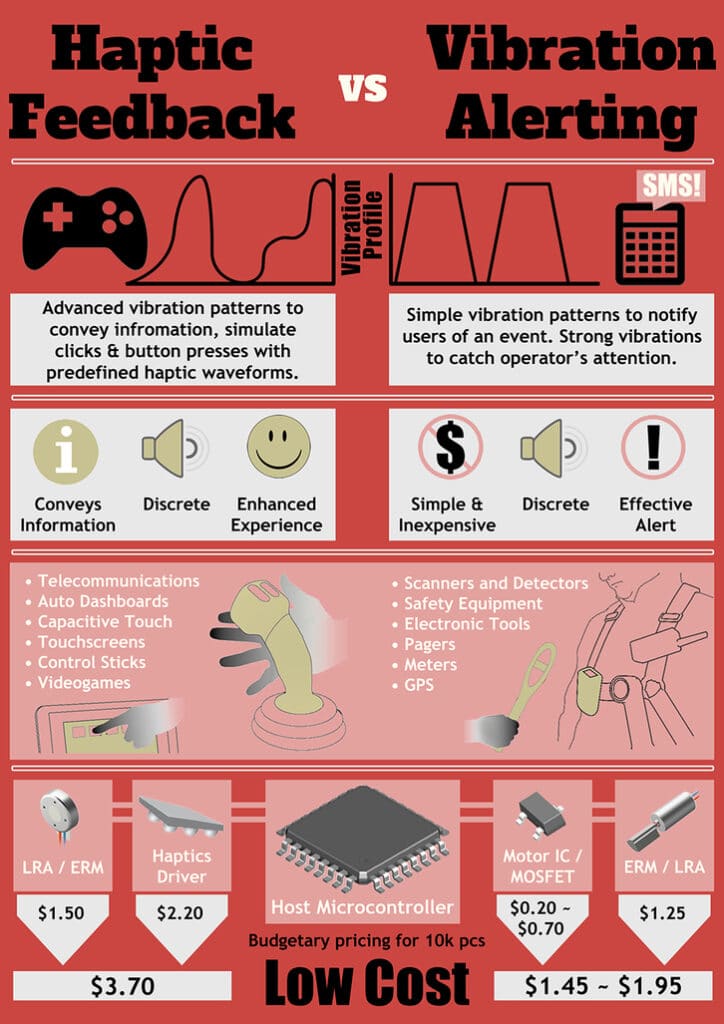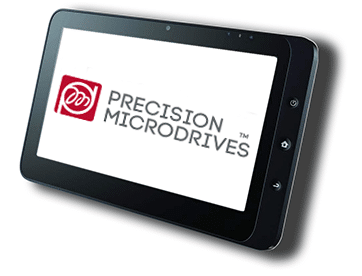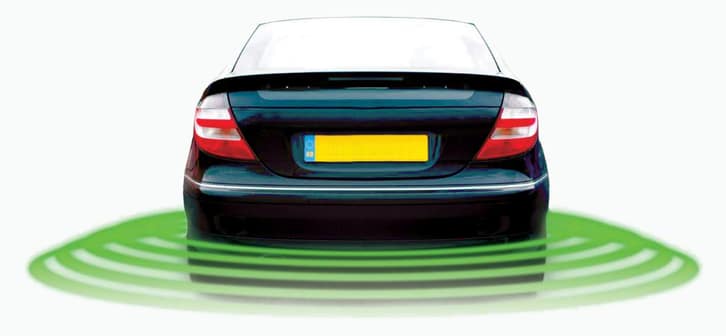Introduction To Haptic Feedback
Looking for our Haptics range? View our main Haptics hub here.
What Is Haptic / Tactile Feedback?
Haptic/Tactile feedback (or haptics) is the use of advanced vibration patterns and waveforms to convey information to a user or operator. The word ‘haptics’ is derived from the Greek phrase ‘I touch’.
Many products are designed to communicate with their users. Historically these have been audible and visual alerts, such as LEDs, beeps and bells, amongst others. Haptic feedback, and its simpler relative ‘vibration alerting’, are in increasing demand to augment or replace the old alert methods.
Haptics uses a vibrating component (sometimes called an actuator) such as a vibration motor or a linear resonant actuator which is driven by an electronic circuit. It is common for a microcontroller to decide when to vibrate and with which pattern, and for a dedicated haptic driver chip to control the actuator. Of course, there are a range of varieties on the engineering side, you can read about them in the Essentials for Haptics section of the Adding and Improving Haptics page. But first, we continue with our introduction to haptic technology.
Where Can I Find Haptic Feedback?
Whilst the old LEDs and other notification methods are still effective in many applications, there are many others where product functionality can be improved by replacing or combining our sense of hearing and sight with our sense of touch.
Adding haptic feedback has two major benefits for manufacturers. First, it can improve the user experience. Even everyday products are now being built with touch displays and interfaces. They’re cheaper to construct than control panels with buttons or switches, and designers can make context-specific user interfaces simply by changing the graphical layout on the screen.
Second, haptics can also improve the performance of operators. Using vibrations to transmit information through the control system allows the user to concentrate on the task at hand. This can range from simpler input confirmations, safety alarms, or even positioning information. Medical applications that use a haptic confirmation when data has been entered have been proven to help reduce patient miss dosing in hospitals.

Get in touch
Speak to a member of our team.
Motor catalogue
Looking for our products?
Reliable, cost-effective miniature mechanisms and motors that meet your application demands.
The Difference Between Haptic Feedback And Vibration Alerting
This is often an area of confusion, especially because there are no strict guidelines as to what separates the two. In truth, they are both very similar. Here at Precision Microdrives, we define the difference between haptics and vibration alerting by the complexity of the vibration pattern.
Although they both use vibrations to communicate with the user, the key difference is that haptic feedback devices often use a variety of advanced waveforms to convey information to the user. Vibration alerting products are less complicated and are generally designed to produce a strong enough vibration to alert the user of an event.
Imagine a reversing car’s parking sensor whereupon coming within 50 cm of an object the steering wheel begins to vibrate. This is an example of vibration alerting as it notifies the user of an event with a simple vibration pattern. In reality, the driver would prefer to know how far they are from the object. With haptic feedback, we can transmit this information to the driver by varying the vibration strength or frequency over a range of distances. This also removes the high pitched beeping found on current sensors and ensures the driver can use the parking sensor if they are in a loud environment or hard of hearing.
Here’s a useful infographic to help highlight the key differences between the two technologies:

How Can I Experience Haptic Feedback?
Experiencing basic haptic feedback is fairly easy. As we mentioned above, it is present in a variety of real-world applications and products. Most will easily understand simple haptics from using their smartphone, although this is just scratching the surface.
If you’re interested in experimenting with advanced haptic feedback, but don’t want to build the detailed circuitry, then our Haptic Feedback Evaluation Kit is the perfect solution. A list of all of its features can be found here, and you can order it online through our product catalogue.
By simulating both a handheld product and a mounted capacitive touch surface in one kit, you can evaluate haptic feedback and easily share your findings with colleagues and managers. It is an easy first step to improving your product with haptics.
Alternatively, if you are ready to (or more interested in) build your own system, you can read our “Adding and Improving Haptic Feedback” page for circuit and design details on what is required for an effective haptic feedback solution. For further reading, see how we created our evaluation kit here.


Newsletter
Sign up to receive new blogs, case studies and resources – directly to your inbox.

Sign up
Discover more
Resources and guides
Discover our product application notes, design guides, news and case studies.
Case studies
Explore our collection of case studies, examples of our products in a range of applications.
Precision Microdrives
Whether you need a motor component, or a fully validated and tested complex mechanism – we’re here to help. Find out more about our company.